Intrathecal injection of brilliant blue G, a P2X7 antagonist, attenuates the exercise pressor reflex in rats
- PMID: 32609538
- PMCID: PMC7473894
- DOI: 10.1152/ajpregu.00093.2020
Intrathecal injection of brilliant blue G, a P2X7 antagonist, attenuates the exercise pressor reflex in rats
Abstract
Purinergic 2X (P2X) receptors on the endings of group III and IV afferents play a role in evoking the exercise pressor reflex. Particular attention has been paid to P2X3 receptors because their blockade in the periphery attenuated this reflex. In contrast, nothing is known about the role played by P2X receptors in the spinal cord in evoking the exercise pressor reflex in rats. P2X7 receptors, in particular, may be especially important in this regard because they are found in abundance on spinal glial cells and may communicate with neurons to effect reflexes controlling cardiovascular function. Consequently, we investigated the role played by spinal P2X7 receptors in evoking the exercise pressor reflex in decerebrated rats. We found that intrathecal injection of the P2X7 antagonist brilliant blue G (BBG) attenuated the exercise pressor reflex (blood pressure index: 294 ± 112 mmHg·s before vs. 7 ± 32 mmHg·s after; P < 0.05). Likewise, intrathecal injection of minocycline, which inhibits microglial cell output, attenuated the reflex. In contrast, intrathecal injection of BBG did not attenuate the pressor response evoked by intracarotid injection of sodium cyanide, a maneuver that stimulated carotid chemoreceptors. Moreover, injections of BBG either into the arterial supply of the contracting hindlimb muscles or into the jugular vein did not attenuate the exercise pressor reflex. Our findings support the hypothesis that P2X7 receptors on microglial cells within the spinal cord play a role in evoking the exercise pressor reflex.
Keywords: autonomic function; glia; purinergic receptors; spinal cord.
Conflict of interest statement
No conflicts of interest, financial or otherwise, are declared by the authors.
Figures
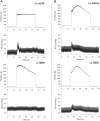
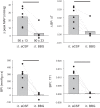
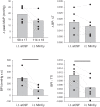
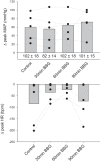
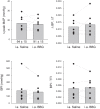
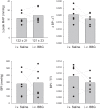
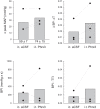
Similar articles
-
Combined, but not individual, blockade of ASIC3, P2X, and EP4 receptors attenuates the exercise pressor reflex in rats with freely perfused hindlimb muscles.J Appl Physiol (1985). 2015 Dec 1;119(11):1330-6. doi: 10.1152/japplphysiol.00630.2015. Epub 2015 Oct 15. J Appl Physiol (1985). 2015. PMID: 26472871 Free PMC article.
-
Purinergic 2X receptors play a role in evoking the exercise pressor reflex in rats with peripheral artery insufficiency.Am J Physiol Heart Circ Physiol. 2014 Feb;306(3):H396-404. doi: 10.1152/ajpheart.00762.2013. Epub 2013 Nov 27. Am J Physiol Heart Circ Physiol. 2014. PMID: 24285113 Free PMC article.
-
Effects of peripheral and spinal κ-opioid receptor stimulation on the exercise pressor reflex in decerebrate rats.Am J Physiol Regul Integr Comp Physiol. 2014 Aug 1;307(3):R281-9. doi: 10.1152/ajpregu.00156.2014. Epub 2014 Jun 11. Am J Physiol Regul Integr Comp Physiol. 2014. PMID: 24920732 Free PMC article.
-
Novel role for purinergic 2× subtype 4 (P2X4) receptors in the exercise pressor reflex and mechanoreflex: Effect of heart failure.Auton Neurosci. 2025 Aug;260:103277. doi: 10.1016/j.autneu.2025.103277. Epub 2025 Apr 5. Auton Neurosci. 2025. PMID: 40233602
-
The exercise pressor reflex and peripheral artery disease.Auton Neurosci. 2015 Mar;188:69-73. doi: 10.1016/j.autneu.2014.10.014. Epub 2014 Oct 22. Auton Neurosci. 2015. PMID: 25458431 Free PMC article. Review.
Cited by
-
Sex differences in the purinergic 2 receptor-mediated blood pressure response to treadmill exercise in rats with simulated peripheral artery disease.Am J Physiol Regul Integr Comp Physiol. 2024 Jun 1;326(6):R449-R460. doi: 10.1152/ajpregu.00010.2024. Epub 2024 Mar 18. Am J Physiol Regul Integr Comp Physiol. 2024. PMID: 38497127 Free PMC article.
-
A narrative review of methane in treating neurological diseases.Med Gas Res. 2023 Oct-Dec;13(4):161-164. doi: 10.4103/2045-9912.372663. Med Gas Res. 2023. PMID: 37077112 Free PMC article. Review.
-
Protective role of methane in traumatic nervous system diseases.Med Gas Res. 2024 Sep 1;14(3):159-162. doi: 10.4103/mgr.mgr_23_23. Epub 2024 Mar 20. Med Gas Res. 2024. PMID: 40232698 Free PMC article. No abstract available.
-
Inhibition of P2X7 Purinergic Receptor Ameliorates Fibromyalgia Syndrome by Suppressing NLRP3 Pathway.Int J Mol Sci. 2021 Jun 16;22(12):6471. doi: 10.3390/ijms22126471. Int J Mol Sci. 2021. PMID: 34208781 Free PMC article.
-
Epidural and Intrathecal Drug Delivery in Rats and Mice for Experimental Research: Fundamental Concepts, Techniques, Precaution, and Application.Biomedicines. 2023 May 10;11(5):1413. doi: 10.3390/biomedicines11051413. Biomedicines. 2023. PMID: 37239084 Free PMC article. Review.
References
Publication types
MeSH terms
Substances
Grants and funding
LinkOut - more resources
Full Text Sources

